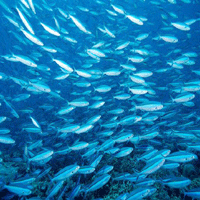
A wonderful world of incredible beauty and amazing facts lies in the sea. The astonishing details truly, has fascinated many people around the world to the great depth of the sea. The varied diversity in flora and fauna with the adaptations of the sea life makes this world the largest ecosystem on this planet. Oceans and Sea with different climatic conditions and geography coupled with habitation in and around takes us to the infinite vistas of research and study.
.Portraying interesting facts about different sea animals, they are like sea whales, sharks, seahorses, dolphins, deep sea fishes, marine plants, micro-organisms, marine products is the major objective of the site. Deep sea explorations,Deep sea research has been categorically sorted out for reference. A collection of deep sea pictures and wallpapers will truly render you to the facts about sea-life if you are unknown about the mesmerizing beauty under the sea. Sea otters and sea lions in their sea caves have been one of the interesting part of study for the scientists. Other topics include the study on sea turtles and sea birds, octopus etc. Their migration and adaptations to Sea life gives a different dimension to the study of evolution. Sea shells ,sponges, corals, sea cucumbers, are a beauty to watch in the sea.
Most of the people know only few animals which they are seeing in their day to day life or on television. Hardly, few people have got a bit of knowledge about deep sea animals. Nearly all the people are well aware that the most common sea animals are fish. But they don't have any idea about the deep sea creatures which can be seen only in the deepest zone of the sea because they survive at the down part of the ocean.
|
The down part of the ocean seems extremely cool because sunlight cannot be reach up to the bottom of the sea. But the sea creatures which are living at the bottom of the sea produce some kind of light. Nearly all the deep sea animals have a kind of sect in their body which produces light.
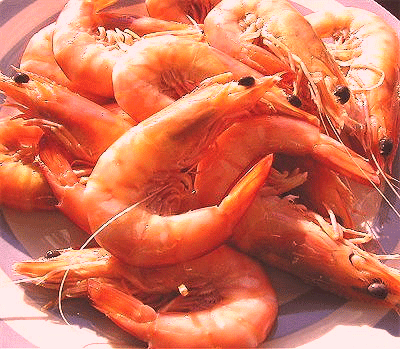 |
Deep sea creatures can easily see with the help of light which they produce because most of them will be in black color. Still there are some deep sea animals like prawns are in light red color and this is the reason which makes it tough for them to be trapped.
|
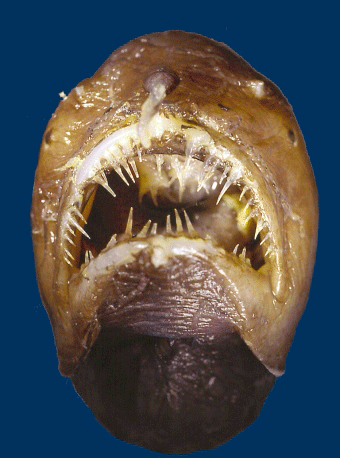 |
Nearly all the deep sea creatures will die if they brought up to the sunset zone from the bottom of the sea. The reason of their death will be the detonation of their eyes and other organs. There are a number of fish; mainly theLantern and Hatchet fish go to the surface area to seize their prey. Animals of the deep-sea produce a kind of light which comes from their body cell and the color of the light seems greenish-yellow.
| 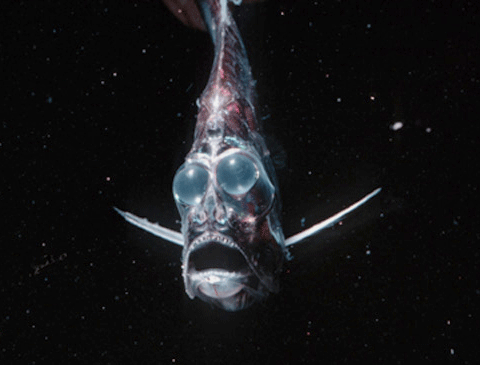 |
The body of deep sea creatures seems very soft and this is reason they can live in the bottom of the ocean. Most of the deep sea animals have soft body and some of them are sea anemones and jellyfish. You can have some knowledge by reading following details about few deep sea animals:
1. Anoplogaster cornuta or fangtooth is a scary looking sea animal that resides in the down part of the deep-sea. Even though the size of this creature is nearly 6 inches but they look like a sea giant. With the short size body they have big head and in that huge extra-large mouth they have very sharp, long and fang-like teethe. This sea creature lives in the extreme deep-water and they eat anything whatever they find. The color of the body of this animal will be dark.
2. The vague giant squid is one of the largest creatures of the world. There are few sea animals like octopus and other squids come in the same species. They also eat any thing whatever they find. Their body looks soft and the color of the body seems from brown to dark.
3. The coffin fish also one of the deep sea creature which has a long tail along with soft body. This animal has black coating mouth with one illicium on the nose.
1. Anoplogaster cornuta or fangtooth is a scary looking sea animal that resides in the down part of the deep-sea. Even though the size of this creature is nearly 6 inches but they look like a sea giant. With the short size body they have big head and in that huge extra-large mouth they have very sharp, long and fang-like teethe. This sea creature lives in the extreme deep-water and they eat anything whatever they find. The color of the body of this animal will be dark.
2. The vague giant squid is one of the largest creatures of the world. There are few sea animals like octopus and other squids come in the same species. They also eat any thing whatever they find. Their body looks soft and the color of the body seems from brown to dark.
3. The coffin fish also one of the deep sea creature which has a long tail along with soft body. This animal has black coating mouth with one illicium on the nose.
Deep Sea Explorations
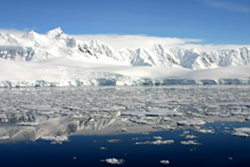 Vast expansion of the blue ocean is always an intriguing sight. It embodies the under water world of animals, plants, insects apart from great secrets, treasures, misfortunes and resources. Primarily, the sea was explored to unearth the wreck of a ship laden with expensive goods. These excavations opened the doors to look into what the sea had to offer by itself just like mother earth. Hidden in its expanse are resources like oil, electricity, precious stones like pearls and corals, volcanoes, mountains and most importantly, stupendously resplendent collection of fishes for consumption and art. What started a quest for treasure led to some astonishing discoveries in the field of science and marine engineering. Using modern, cutting-edge technology we are now able to explore some of these areas and answer the many questions relating to them.Such exploration will continue to make a major contribution to our general understanding and appreciation of the oceans.
Vast expansion of the blue ocean is always an intriguing sight. It embodies the under water world of animals, plants, insects apart from great secrets, treasures, misfortunes and resources. Primarily, the sea was explored to unearth the wreck of a ship laden with expensive goods. These excavations opened the doors to look into what the sea had to offer by itself just like mother earth. Hidden in its expanse are resources like oil, electricity, precious stones like pearls and corals, volcanoes, mountains and most importantly, stupendously resplendent collection of fishes for consumption and art. What started a quest for treasure led to some astonishing discoveries in the field of science and marine engineering. Using modern, cutting-edge technology we are now able to explore some of these areas and answer the many questions relating to them.Such exploration will continue to make a major contribution to our general understanding and appreciation of the oceans.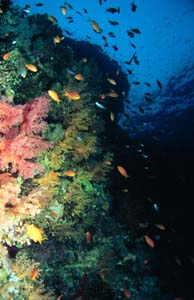 Basically, the sea bed was researched for the undeterred building and sail of submarines, submersibles invented during the world wars as a weapon for combat. Later on for more constructive reasons, they were taken for scientific observations. The depth of the sea was measured to pave way for laying under water cables for communication. They used sound weight machines to measure the depth of the sea. A long pole with weights were lowered into the sea bed. When it touched the sea bed with a thud, the depth of the sea was calculated. These statistics were then taken into account to build harbours, naval bases, install oil excavating machinery, and other activities. We can categorize the explorations into two types. Scientific explorations and environmental explorations. Nowadays under water explorations attract a lot of tourists as well.Deep-sea exploration is the examination of physical, chemical, and biological conditions on the sea bed, for scientific or commercial purposes. Deep-sea exploration is a relatively recent human activity; the depths of the sea are at a halt a largely unknown part of the planet earth.
Basically, the sea bed was researched for the undeterred building and sail of submarines, submersibles invented during the world wars as a weapon for combat. Later on for more constructive reasons, they were taken for scientific observations. The depth of the sea was measured to pave way for laying under water cables for communication. They used sound weight machines to measure the depth of the sea. A long pole with weights were lowered into the sea bed. When it touched the sea bed with a thud, the depth of the sea was calculated. These statistics were then taken into account to build harbours, naval bases, install oil excavating machinery, and other activities. We can categorize the explorations into two types. Scientific explorations and environmental explorations. Nowadays under water explorations attract a lot of tourists as well.Deep-sea exploration is the examination of physical, chemical, and biological conditions on the sea bed, for scientific or commercial purposes. Deep-sea exploration is a relatively recent human activity; the depths of the sea are at a halt a largely unknown part of the planet earth.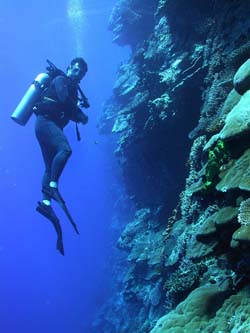 Science has aided mankind in leaps and bounds to understand the apprehensions of mother nature. Nevertheless, underwater science has also developed to unprecedented levels and helped in preserving the balance of nature. Oil and petroleum were meant to be found on land only, but a path breaking discovery found oil in the deep depths of the ocean. There is also the Trans Channel railway between London and Paris that ply in the sea bed of the English Canal. Marine biologists and environmentalists have always been interested by the study of under water creatures.They throw light into the life and habitats of the deep sea creatures, their adaptations to the environment and their fight for survival. A study into their habitats can also warn us against natural disasters. It is found that deep sea creatures can warn us against natural calamities. Their sensory system is emits fluorescent light signals before a catastrophe like Tsunami or Hurricanes. Detecting fluorescence can allow scientists to spot animals that would otherwise be too effectively camouflaged to see. Fluorescence is also important because the proteins that allow animals to fluoresce are used in genetic research and new fluorescent animals may contain proteins that offer novel benefits in such work.
Science has aided mankind in leaps and bounds to understand the apprehensions of mother nature. Nevertheless, underwater science has also developed to unprecedented levels and helped in preserving the balance of nature. Oil and petroleum were meant to be found on land only, but a path breaking discovery found oil in the deep depths of the ocean. There is also the Trans Channel railway between London and Paris that ply in the sea bed of the English Canal. Marine biologists and environmentalists have always been interested by the study of under water creatures.They throw light into the life and habitats of the deep sea creatures, their adaptations to the environment and their fight for survival. A study into their habitats can also warn us against natural disasters. It is found that deep sea creatures can warn us against natural calamities. Their sensory system is emits fluorescent light signals before a catastrophe like Tsunami or Hurricanes. Detecting fluorescence can allow scientists to spot animals that would otherwise be too effectively camouflaged to see. Fluorescence is also important because the proteins that allow animals to fluoresce are used in genetic research and new fluorescent animals may contain proteins that offer novel benefits in such work.
Off late, marine tourism is catching up. Nature rich countries like Thailand ,New Zealand and Australia offer under water cruises or snorkeling where you can explore the treasure of coral reefs, underwater flora and fauna, swim with sharks, dolphins and whales. The sea has so much to offer for humanity that it is always underestimated to be a shelter of fishes and their clan.
What's to see in the Ocean?
Solar Powered The ocean plays an essential role in the world's climate system, absorbing about half the heat from the sun. The heat escapes to warm the atmosphere, mainly through evaporation either locally or months or years later having been transported by ocean currents thousands of kilometres.
The ocean plays an essential role in the world's climate system, absorbing about half the heat from the sun. The heat escapes to warm the atmosphere, mainly through evaporation either locally or months or years later having been transported by ocean currents thousands of kilometres.
The upper three metres of the ocean can hold more heat than the entire atmosphere, and sea surface and subsurface temperatures are now used by meteorologists when they make climate forecasts.
The sun's energy also drives large-scale wind systems and cells in the atmosphere. In turn, the winds, along with sinking cold water in the polar and subpolar oceans, drive the ocean. The resulting ocean currents redistribute the energy absorbed from the sun throughout the world's oceans, carrying it away from the region of greatest heat in the tropics towards the colder polar regions.
Australia's climate variability is strongly influenced by the Pacific Ocean, the El Niño/Southern Oscillation phenomenon and sea surface temperature patterns in the Indian and Southern Oceans. Long term, the Southern Ocean is critical in evaluating the timing and regional impacts of climate change.
Ocean Circulation
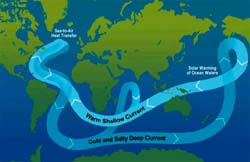 Winds move across the earth's surface towards the west near the equator (trade winds) and towards the east in the temperate mid-latitudes (Westerlies and Roaring Forties). Their effects create large circulation patterns in each of the Atlantic, Indian and Pacific Ocean basins, moving clockwise north of the equator and anticlockwise south of the equator.
Winds move across the earth's surface towards the west near the equator (trade winds) and towards the east in the temperate mid-latitudes (Westerlies and Roaring Forties). Their effects create large circulation patterns in each of the Atlantic, Indian and Pacific Ocean basins, moving clockwise north of the equator and anticlockwise south of the equator.
The gyres (or circular motions) move water from equatorial to polar regions along the eastern coasts of continents as intense warm currents (like the East Australia Current). In regions near the equator, water in the gyres also moves vertically, bringing cooler water towards the surface. When warmer water moves south towards the Antarctic, it releases its heat into the atmosphere.
In the deep ocean (at depths below about one kilometre), water movement is governed by variations in the density of water. In the Arctic and Antarctic regions, surface waters become very dense as they cool. In addition, this density is increased as sea-ice forms, releasing salts to the water. Cold saline (dense) water sinks to the bottom of the ocean, then circulates along the ocean floor, slowly mixing upwards over decades or even centuries.
Along the coastlines, local effects such as tides and coastal winds, sediments, nutrients and rainfall run-off combine to influence the behaviour of continental seas.
Physical components of an ocean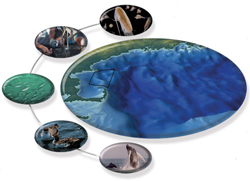 The ocean has other physical components and external influences governing its behaviour.
The ocean has other physical components and external influences governing its behaviour.
Waves are generated by wind and may travel thousands of kilometres across the oceans. Engineers must have a knowledge of the potential force of waves in extreme conditions when they design coastal shipping facilities and oil drilling platforms.
Ocean currents transport water in varying volumes. The Antarctic Circumpolar Current, the world's largest ocean current, can move around 150 times the volume of Sydney Harbour per second (500,000 megalitres) and even the much smaller Leeuwin Current transports five to ten 'Sydney Harbours' per second down the coastline of Western Australia. The strength, direction and volume of water carried by ocean currents can vary from season to season and from year to year, influenced in complex ways by factors such as El Niño.
In cross-section, the ocean is like an onion with many different water layers. The surface layer may be tens of metres thick. Beneath it are other layers that originate from thousands of kilometres away. For example, two of the deep layers off the Australian east coast originate in the Northern Hemisphere and in the Antarctic. Oceanographers infer the origins of these waters from their temperature and salinity, which together are effectively their signatures.
Ocean eddies are formed on the edge of strong ocean currents; they are typically 100-200 kilometres in diameter and circulate both clockwise and anti-clockwise. They are detected by satellite as roughly circular patches of high or low water and may contain currents of up to four knots, be as deep as one kilometre and circulate for several years before losing momentum. These eddies are similar to the high and low pressure systems in the weather charts. Oceanographers can track the speed and direction of ocean eddies by studying photographs taken by satellite.
Scientific interpretation of how ocean eddies form and their effects is important in mapping ocean circulation. Such information is sought by authorities such as the Australian Maritime Safety Authority for search and rescue at sea and also for environmental protection.
Upwelling is another phenomenon of oceans. It occurs when strong winds bring dense waters to the surface, against the force of gravity. Upwelling is important to the ocean ecosystems because it solves the dilemma of life in the ocean. For example, how does the food-chain begin when sunlight is only available near the surface, but essential nutrients from decaying organic matter are on the ocean floor? The answer is that upwelling returns nutrients to the surface. The richer fishing grounds of the world depend on a flourishing food chain, and it is interesting to note that Australia does not have any really rich fishing grounds because the winds here are generally not conducive to upwelling.
Read More: http://kambingputihblog.blogspot.com/
No comments:
Post a Comment